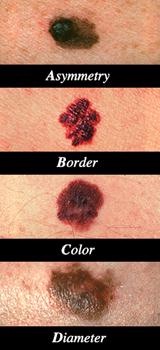Clearly, everyone who sits in the sun is not going to get  skin cancer. But the numbers do make you think twice: This
year more than one million Americans will develop one of the
three forms of skin cancer — basal cell carcinoma, squamous
cell carcinoma, and malignant melanoma — and over 90
percent of these cancers will appear on sun-exposed skin,
usually on the face, neck, ears, forearms, and hands. What's
more, every hour an American dies from skin cancer.
skin cancer. But the numbers do make you think twice: This
year more than one million Americans will develop one of the
three forms of skin cancer — basal cell carcinoma, squamous
cell carcinoma, and malignant melanoma — and over 90
percent of these cancers will appear on sun-exposed skin,
usually on the face, neck, ears, forearms, and hands. What's
more, every hour an American dies from skin cancer.
How
it happens
The connection between the sun's powerful ultraviolet UVA
and UVB rays and skin cancer is indisputable. In a nutshell,
overexposure to those rays ravages our skin cells, which are
made up of two layers. The top layer, or epidermis, includes
three types of cells: flat, scaly squamous cells; round basal
cells; and melanocytes, the cells that give skin its color.
It's these last cells that are most vulnerable. Too much sun
prompts visible damage (like sunburn or tanning) as well as
invisible, cellular-level damage that adds up over the years.
Depending on the individual, that damage can eventually prompt
wrinkles, age spots, and, often, skin cancer.
Melanoma
Of the three cancers, potentially fatal melanoma is the most
serious. Nearly 40,000 Americans will develop it this year.
"Malignant melanoma is the emerging common cancer in young
adults and in women in their 20s and 30s, second only to breast
cancer," says Alan M. Houghton, M.D., the principal investigator
in a melanoma vaccine study sponsored by the Memorial Sloan
Kettering Cancer Center in New York. Squamous cell carcinoma
and basal cell carcinoma are just as dangerous if they spread,
but they're curable if you catch them early; that's why detection
is so important. So if you see any changes in the skin, such
as a growth, a sore that doesn't heal, or moles that are starting
to look irregular, consult your dermatologist immediately.
And if a family member has had melanoma or you have a high
number of moles, Dr. Houghton suggests seeing a dermatologist
once or twice a year.
Melanoma usually begins as a dark brown or black patch with irregular borders and is characterized by the uncontrolled growth of pigment-producing tanning cells. It may appear anywhere on the body without warning or start near a mole. It has a tendency to spread, making it essential to treat it right away. Since melanoma is often linked to a change in one of your moles (most of us have 100 or so), you should inspect them regularly and look for any changes in their size and color, such as the appearance of a bump or the spreading of pigment around the border. The Skin Cancer Foundation and the American Academy of Dermatology recommend using the ABCD method (see photos above) to help detect melanoma: A (most early melanomas are asymmetrical); B (borders of melanomas are uneven); C (color; varied shades of brown, tan, or black are often the first sign of melanoma); and D (diameter; early melanomas tend to grow larger than common moles).
 Squamous and basal cell carcinomas
Squamous and basal cell carcinomas
The second most common skin cancer in Caucasians is squamous
cell carcinoma, which begins in the squamous cells of the
epidermis. You'll often see scaly patches or raised growths
on your skin in such places as the tip of your nose, or on
your forehead, lower lip, or hands. Since this carcinoma can
spread, spotting these growths early on is critical. The third
kind of cancer, basal cell carcinoma, often starts as small,
fleshy bumps on your face, ears, lips, or around your mouth.
These bumps ma become crusty or may not heal easily and, even
though the tumors rarely spread to other parts of the body,
they can continue to grow, making it essential to have them
removed.
"If you have a question about a change in your skin or a mole, don't wait," says Wilma Bergfeld, M.D., a dermatologist at the Cleveland Clinic. "One of my patients was a young dentist who had just finished with his training. He had a brown mole on his belly and never removed it. Two years later, it bled. And, even though we removed it, the cancer had already spread to his brain and liver. Don't put off removing something suspicious."
Photographs
courtesy The Skin Cancer Foundation, copyright 1985
© 1997 by The Hearst Corporation; all rights reserved
Memorial
Sloan Kettering Cancer Center
American Academy of Dermatology
Cleveland Clinic
Disclaimer and Reproduction Information: Information in NASD does not represent NIOSH policy. Information included in NASD appears by permission of the author and/or copyright holder. More